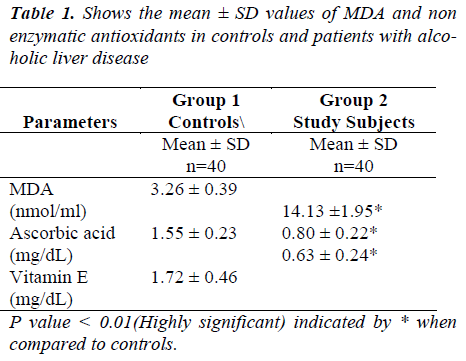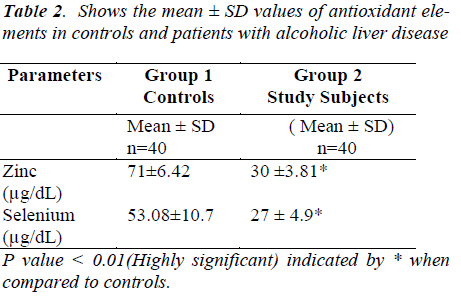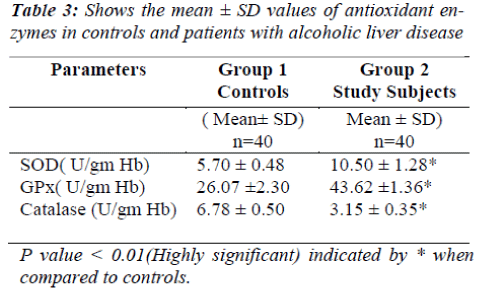ISSN: 0970-938X (Print) | 0976-1683 (Electronic)
Biomedical Research
An International Journal of Medical Sciences
- Biomedical Research (2012) Volume 23, Issue 1
Oxidative stress and antioxidative status in patients with alcoholic liver disease
1Department of Biochemistry, Sinhgad Dental College & Hospital, Pune (MS), India
2Department of Biochemistry, Govt Medical College, Miraj (MS), India
3Department of Biochemistry, MVPS Dr Vasantrao Pawar Medical College, Nashik (MS), India
4Department of Biochemistry, Sinhgad Dental College & Hospital, Pune (MS), India
- *Corresponding Author:
- Ashok V Shinde
Department of Biochemistry
Sinhgad Dental College and Hospital
Pune Vadgaon Campus
Maharashtra 411041, India
Accepted date: December 17 2011
The exact pro-oxidant and antioxidant status in alcoholic liver disease among the chronic alcoholics is still not clear. Alcoholic liver disease (ALD) & its complications are still one of the most frequent causes of death in both developing and developed counties. The present study was conducted to add a new insight to the question, whether ethanol induces oxidative stress, change in the level of antioxidant vitamins ascorbic acid & vitamins E (non- enzymatic antioxidant parameters), trace elements Zinc & Selenium & activities of antioxidant enzymes superoxide dismutase (SOD), glutathione peroxidase (GPx) & catalase in erythrocytes. Study was performed in 40 patients with alcoholic liver disease (study subject) & compared to 40 age & sex matched healthy subject (controls). It was observed that they was a significant increase in MDA (Malondialdehyde), SOD, GPx and significant decrease in ascorbic acid, vitamin E, zinc, selenium & catalase activity in patients with alcoholic liver disease when compared to controls. The results of our study have shown higher free radical production, as evidenced by the increased MDA & decreased levels of ascorbic acid, vitamin E, selenium & catalase activity, supporting the hypothesis that they is increased oxidative stress in patients with ALD. The increased activities of antioxidant enzymes may be a compensatory regulatory response to increased oxidative stress. The decreased antioxidative status support the hypothesis that lipid peroxidation is an important causative factor in the pathogenesis of ALD. These data clearly indicates that, antioxidant mechanisms might be impaired in these patients. These findings also provide a therotical basis for the development of novel therapeutic strategies such as antioxidant supplementation.
Keywords
Alcoholic liver disease, Malondialdehyde, Ascorbic acid, Vitamin E, Superoxide dismutase, Glutathione peroxidase, Catalase.
Introduction
Alcoholic liver disease (ALD) is the disease considered to be a major cause of morbidity & mortality, with increasing incidence day by day especially in the developing countries including India [1]. Alcohol intake remains the most important cause of cirrhoses in the Western World [2]. Excessive consumption of alcohol (ethanol) by large section of the population is still an important medical & social problem in many countries of the world. It leads to various physical, mental & psychological changes. Chronic consumption of alcohol causes accumulation of fat in liver [3]. The ingested alcohol in chronic alcoholics also alters various metabolic pathways inside the liver, which ultimately leads to the production of reactive oxygen species (ROS) [4]. Free radicals are formed in both physiological & pathological conditions in mammalian tissues [5]. Influence of free radicals & presence of oxidative damage that is alteration in the oxidant- antioxidant profile is known to occur in chronic alcoholism [6]. Antioxidants are compounds that dispose, scavenge & suppress the formation of free radicals, or oppose their actions [7]. They exist in both the aqueous and membrane compartment of cells & can be enzymes or non-enzymes.
In our previous study we showed that lipid peroxidation was significantly increased along with significant decrease in antioxidant vitamin levels in patients with alcoholic liver disease [8]. However we have not studied trace elements especially zinc, selenium and antioxidant enzymes especially glutathione peroxidase. Another reason for selecting this study is that many research groups in the past have tried to study & confirm oxidative stress induced by alcohol. These studies included mainly animal experiments and very few human studies. To throw more light on these aspects we have undertaken this study and decided to measure the level of antioxidant vitamins, trace elements and enzymes along with MDA and compared with controls.
Material and Methods
Present study was carried in the department of Biochemistry, Govt Medical College, Miraj and Sinhgad dental college and hospital, Pune. The study group comprised of 40 male patients of alcoholic liver disease, having history of alcohol intake of 80-100 gms / day continuously for more than 10 years. 40 normal age matched healthy male volunteers served as controls. Written consents were taken from the patients prior to the study. Patients were subjected to detailed clinical examination and laboratory investigations. Severely ill patients with terminal stage, cases with multi organ involvement & those suffering from hepatitis / cirrhosis / jaundice not related to alcohol were excluded from the present study. Patients with age below 35 and above 60 years were also excluded from the study. Controls and Patients were divided into 2 groups.
Group I -- 40 healthy age matched controls.
Group II -- 40 patients with alcoholic liver disease.
Fasting venous blood samples were collected for estimation of following various biochemical parameters.
a) Serum MDA by Kei Satoh method [9].
b) Serum ascorbic acid and vitamin E by Ayekyaw [10] and Baker [11] method respectively.
c) Serum Zinc (Zn) and Selenium (Se) by atomic absorption spectrophotometer (Perkin –Elmer Model 5000) [12].
d) Erythrocyte SOD and CAT by Marklund [13] & Aebi [14] method respectively.
e) The activity of Glutathione peroxidase (Gpx, EC 1.11.1.9) was measured as described by Paglia & Valentine in erythrocytes [15].
All reagents used were of analytical reagent grade & were obtained from sigma chemicals, st Louis, MO.
Ethical approval of institutional ethical committee was obtained before doing the present study.
Statistical Analysis
Statistical analysis between group I (Controls) & group II (Study subjects) was performed by the student’s t- test using SPSS package for windows. The data were expressed as mean ± SD. P < 0.01 was considered as significant.
Results
The results of research parameters in patients and healthy subjects are presented in 3 tables.
Table 1 shows significant rise (P < 0.01) in MDA levels (14.13 ± 1.95) in patients with alcoholic liver disease as compared to controls. There was also significant decrease (P < 0.01) in levels of antioxidant vitamins ascorbic acid (0.80 ± 0.22) and vitamin E (0.63 ± 0.24) in these patients.
Table 2 shows there was significant decrease (P < 0.01) in the levels of antioxidant elements zinc (30 ± 3.81) & selenium (27 ± 4.9) in patients with alcoholic liver disease when compared to controls.
The mean ± SD of erythrocyte SOD, GPx, and catalase are indicated in Table 3. There was statistically significant increase in the erythrocyte antioxidant enzymes SOD (10.50 ±1.28), GPx (43.62 ± 1.36) activity in patients with alcoholic liver disease as compared to controls. The level of erythrocyte catalase activity was significantly decreased (3.15 ± 0.35) in group II (Study subjects) when compared to group I (Controls).
Discussions
In our study we have showed that, there was significant increase in lipid peroxidation and significant decrease in the level of antioxidant vitamins and trace elements. Further we have also showed the increased activity of antioxidant enzymes except catalase in patients with alcoholic liver disease compared to controls.
Alcohol consumption is associated with a number of changes in cell functions and the oxidnt-antioxidant system. Acute and chronic ethanol treatment has been shown to increase the production of reactive oxygen species, lower cellular antioxidant levels & enhance oxidative stress in many tissues especially the liver [16]. Many pathways have been suggested as playing a key role in how ethanol induces oxidative stress. Lipid peroxidation mediated by free radicals is considered to be a primary mechanism of cell membrane destruction. & cell damage [17]. Glutathione (GSH) plays a role in cellular protection against oxidative damage. Chronic alcoholics showed depletion of GSH levels (0.95 ±0.14). Several factors contribute to this fall; most important of which is oxidative stress, which has occurred in our study. Depletion of GSH renders the cells more susceptible to oxidative stress.
We observed a significant decrease in antioxidant vitamins in alcoholic patients. Free radical generation can induce oxidative stress. The decrease in the level of these vitamins may be due to the increased turnover, for preventing oxidative damage in these patients suggesting an increased defense against oxidative damage in alcoholic liver disease. Previous studies also supported our findings [3.18]. These results indicate that in ALD patients the efficiency of the antioxidant vitamins in counteracting the damaging effects of free radicals is significantly reduced. Thus the result of our present study suggests that cumulative functional insufficiency of the antioxidant vitamin system may play an essential role in the development of oxidative stress in patients with ALD.
In our study we found decreased level of serum zinc and selenium in ALD patients when compared to controls. Other research workers also support our findings [19, 20]. Both inadequate dietary intake of these elements and alcohol induced changes in hepatic structure and function may have contributed to the decrease of these trace elements in the subjects studied. Further it is possible that decreased antioxidant trace elements in combination with reported glutathione depletion, makes the hepatocytes more vulnerable towards the toxicity of ethanol.
In our study, the erythrocyte antioxidant enzymes i.e. Superoxide dismutase (SOD) & Glutathione peroxidase (GPx) activities have been increased significantly in ALD patients. Many authors have come across equivocal or controversial results regarding activities of these enzymes in alcoholics. Both increased and decreased SOD activities in the blood of alcoholics have been reported [21, 22, and 23]. The increase in erythrocyte SOD activity may probable be an adaptive response towards oxidative stress. Our finding regarding SOD activity is supported by the work of DM Vasudevan and Subirkumar Das (24). They found an increase in erythrocyte SOD activity. The probable reason of increase in SOD activity in our study may be that, in alcohol induced oxidative stress; there may be up regulation of enzyme activity towards oxidative stress. Over expression of SOD activity may result in increased dismutation of superoxide to H2O2. Evidence is accumulating that intermediates of oxygen reduction may in fact be associated with the development of alcoholic liver disease. GPx is an oxidative stress inducible enzyme, which plays a significant role in the peroxyl scavenging mechanism & in maintaining functional integrity of cell membranes [25]. The rise in the activity of GPx could be due to its induction to counter the effect of increased oxidative stress. GPx provides an effective protective mechanism against cytological injury, because it eliminates hydrogen peroxide and lipid peroxidation by reduction, utilizing reduced glutathione (GSH) [26].
Our study showed a significant decrease in the activity of erythrocyte catalase in alcoholics. Catalase is the enzyme, which protects the cells from the accumulation of hydrogen peroxide by dismutating it to form water and oxygen or by using it as an oxidant in which it works as a peroxidase [27]. The decrease of enzyme could be due to increase in malondialdehyde which can cross link with amino group of enzyme protein to form intra and intercellular cross-links thereby inactivating several enzymes including catalase [28].
Conclusion
In conclusion, oxidative stress may be involved in chronic alcoholics. The present study clearly demonstrates the higher oxygen free radical production as evidenced by increased levels of MDA and decreased levels of ascorbic acid, vitamin E and catalase activity, supporting the hypothesis that there is increased oxidative stress in patients with alcoholic liver disease. The increased activities of antioxidant enzymes may be a compensatory mechanism in response to increased oxidative stress. The decreased concentration of antioxidant vitamin status support the hypothesis that lipid peroxidation is an important causative factor in the pathogenesis of alcoholic liver disease among chronic alcoholics. These data clearly indicates that antioxidant defense mechanism might be impaired in these patients. These findings also provide a theoretical basis for the development of novel therapeutic strategies such as antioxidant vitamin supplementation. However due to limited number of cases in our study, future study should be planned with more number of cases to substantiate the more results and arrive at a definite conclusion to throw more light on oxidative stress & antioxidative status in patients with ALD.
Acknowledgements
Encouragements and cooperation of Professor Dr Shailesh Lele (Dean) Sinhgad Dental College and Hospital Pune (Maharashtra) is appreciated.
References
- Gupta S, Pandey R, Katyal R, Agarwal HK, Agarwal SK. Lipid peroxide and antioxidant status in alcoholic liver disease. Ind J Clin Biochem 2005; 20(1): 67-71.
- Grant BF, Harford TC. Epidemiology of alcoholic liver disease. Semin Liver Disease 1988; 8:12-25.
- Liber CS. Alcohol and liver: metabolism of alcohol and its role in hepatic and extrahepatic diseases. Mt Sinai J Med 2000; 67 (1): 84-94.
- Liber CS. Biochemical and molecular basis of alcohol induced injury to liver and other tissues. N Eng J Med 1988; 319:1639-1650.
- Tas F, Hansel H, Belce A, et al. Oxidative stress in ovarian cancer. Medical Oncology 2005; 22(1):11-15.
- Albano E. Alcohol, oxidative stress and free radical damage. Proc Nutr Soc 2006; 65:01-13.
- Sie H: Oxidative stress: from basic research to clinical application. Am J Med 1991; 9: 31-38.
- Shinde AV, Ganu JV. Role of antioxidant supplementation in alcohol cirrhosis induced oxidative stress. JARBS 2009; 1(2): 46-51.
- Satoh K. Serum lipid peroxide in cerebrovascular disorders determined by a new colorimetric method. Clinica Chimica Acta 1978; 90 (1): 37- 43.
- Aye K. A simple colorimetric method for ascorbic acid determination in blood plasma. Clinica Chimica Acta 1978; 86: 153-157.
- Baker H, Frank O. Varley’s Practical Clinical Biochemistry. 6th edition. Heinemann professional publishing 1988; pp- 902-903.
- Elmer P, Conn N. Analytical methods for atomic absorption spectrophotometry. London oxfords press 1975; pp- 273-290.
- Marklund S, Marklund G. Involvement of superoxide radical in the autoxidation of pyrogallol: a convenient assay for SOD. Eur J Biochem 1974: 47:469-74.
- Aebi H. Catalase in vitro. Methods enzymology 1984; 105:121-126.
- Paglia DE, Valentine WN. Studies on the quantitative and qualitative characterization of erythrocyte glutathione peroxidase. J Lab Clin Med 1967; 70:158-159.
- Aparajita D, Arthur I. Alcohol & Oxidative liver injury. Hepatology 2006; 43 (1): S63-S74.
- Arteel GE. Oxidants and antioxidants in alcohol induced liver disease. Gastroenterology 2003; 124 (3):778-790.
- Masalkar P, Abhang S. Oxidative stress and antioxidant status in patients with alcoholic liver disease. Clinica Chimica Acta 2005; 355(1-2): 61-65.
- Zarski J, Arnauld J, Dumolard L, et al. Trace elements in alcoholic liver cirrhosis: Effect of chronic alcoholism. Gastroenterol Clinc Biol 1985; 9(10): 664-669.
- Korpela H, Jorma K, Pauli L, et al. Decreased serum selenium in alcoholics as related to liver structure and function. Am J Clin Nutr 1985; 42:147-151.
- Chari S, Gupta M. Status of blood antioxidant enzymes in alcoholic cirrhosis. Ind J Physiology and Pharmacology 2003; 47(3): 343-346.
- Janani AV, Suprapaneni KM. Antioxidant vitamins and enzyme status in patients with alcoholic liver disease. J Clic and Dia Res 2010 Aug ;( 4): 2742-2747.
- Chen YL, Chen LJ, Bair MJ, et al. Antioxidative status of patients with alcoholic liver disease in southeastern Taiwan. World J Gasteroenter 2011; 17(8): 1063-1070.
- Das S, Vasudevan DM. Effects on alcohol on liver antioxidant defense System: a dose dependent study. Ind J Clin Biochem 2005; 20(1):80-84.
- Chandra R, Aneja R, Rewal C, Konduri R, Dass K, Agarwal S. An opaium alkaloid papaverine ameliorates ethanol-induced hepatotoxicity: diminution of oxidative stress. Ind J Clin Biochem 2000; 15(2): 155-160.
- Mahadik SP, Soheffer RE. Oxidative injury and potential use of antioxidants in Schizophrenia. Prostaglandins Leukot Essent Fatty acids 1995; 55:45-54.
- Balkrishnan V, Mukherjee S, Vasudevan DM et al. Evaluation of blood oxidative stress related parameters in alcoholic liver disease and non alcoholic fatty liver disease. Scan J Clin Lab Invest 2008; 68(4): 323-34.
- Kiklugawa K. Effects of MDA, a product of lipid peroxidation on the function and stability of hemoglobin. Arch Biochem Biophysics 1984; 229: 07-10.


